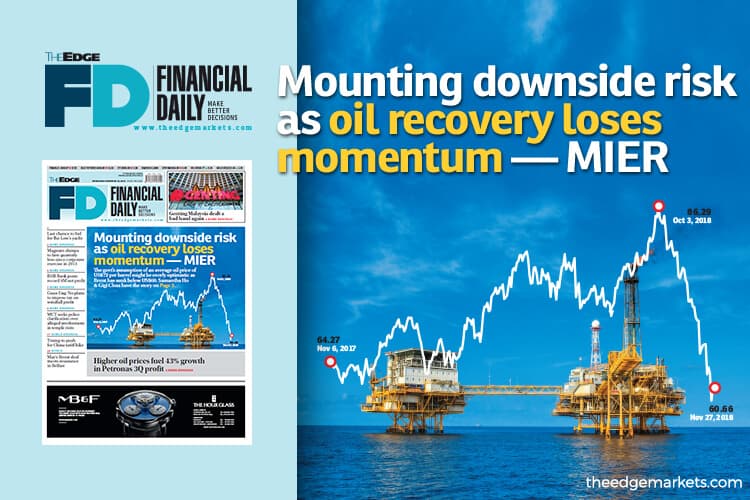
This article first appeared in The Edge Financial Daily on November 28, 2018
KUALA LUMPUR: The country’s economic growth is facing downside risks as the recent decline in crude oil prices and escalating US-China trade tensions cast uncertainty over global economy, according to the Malaysian Institute of Economic Research (MIER).
The reverse of the upward trend in oil price since the start of October will be a double whammy. The soft oil prices will not augur well for the national budget, which has an assumption of US$72 (RM301.68) per barrel compared with Brent crude of US$59.60 per barrel as at press time, and it will hit the local oil and gas industry, which has yet to come out of the doldrums, according to MIER executive director Dr Zakariah Abdul Rashid.
Yesterday, Brent crude hit a one-year low of US$58.80 per barrel. Meetings at the Group of Twenty summit later this week are expected to set a clearer direction for the commodity’s price.
“The decline in oil prices may not be permanent. But if these [current] price levels are prolonged, then Budget 2019 may have to be revised,” Zakariah commented.
Zakariah opined that the government should have been more conservative in its estimates, suggesting that the assumption price should have been pegged at below US$70 per barrel.
It is worth noting that Petroliam Nasional Bhd had forecast in their 2018 to 2020 outlook that Brent crude oil would trade between US$50 and US$60 per barrel.
Apart from the weak crude oil prices, Zakariah also opined that Malaysia may stand to lose from the US-China trade war as both countries are among the nation’s top five trading partners.
Although Malaysia may benefit from trade diversion in sectors, such as oils and fats that could see higher demand from China, its effects have yet to be observed.
“There might be benefits when there is a trade diversion but still, it’s not sure yet whether it’s going to happen or not. We don’t know whether people in China would like to consume cooking oil from Malaysia, so we have to study the behaviour first,” he suggested.
Meanwhile, other sectors that could be negatively affected include tourism due to weaker spending power of Chinese tourists, as well as electrical and electronic (E&E) exports.
“When China wants to produce their products, the country has to import the intermediate input from many countries, including Malaysia [which exports E&E to China]. If they curtail the production, that means they will demand less from Malaysia,” he said.
Zakaria also highlighted that China and the US contribute 40% of the global gross domestic product (GDP) combined, 100 times of Malaysia’s contribution at 0.4%.
“By looking at the sheer numbers, we will definitely be affected,” he added.
That said, other experts opined that Malaysia stood only to gain in the event of trade diversions.
Chikahasa Sumi, director of regional office for Asia and the Pacific of the International Monetary Fund (IMF) is optimistic about Asia benefiting from the liberalising intra-regional trade and investment, especially in services, as the region relies on export.
The Asian Development Bank (ADB), meanwhile, predicted that Malaysia may gain as much as 0.46% of gross domestic product (GDP) from trade redirection.
Separately, Zakariah opined that the ringgit has appreciated significantly against the US dollar since the start of 2017, supported by both economic fundamentals. However, the current poor market sentiment has put a cap on the ringgit’s appreciating trend.
The local currency has gained 7.29% against the greenback during the period. The ringgit traded at 4.1883 against the US dollar yesterday, hovering near its one-year low of 4.196 against the greenback.
According to Zakariah, Malaysia’s economic growth is expected to continue being driven by private consumption and private investment in the fourth quarter of 2018.
However, he cautioned that private investment is likely to face headwinds from external uncertainty and that consumer spending should not be depended on in the long term. “We cannot rely on private consumption [for economic growth] forever because the effect will be felt on household debt,” he said.
MIER kept its GDP estimate at 4.7% for 2018, noting that GDP had averaged 4.76% in the first nine months of the year.
Any positive surprises to growth is likely only to lift full-year GDP as far as 4.8% or 4.9%, Zakariah said, adding that a 5% growth rate is unlikely.
The IMF had recently revised Malaysia’s GDP growth forecast down to 4.7% from 4.8%, while the ADB had a 5% GDP growth estimate as at Sept 2018, down from an earlier projection of 5.3%.